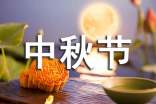- 相关推荐
中秋节的历史英语介绍
中秋节的历史英语介绍【1】

Mid-autumn Day Mid-autumn Day is a Chinese festival.
It usually comes in September or October .
On that day we usually eat a big dinner and mooncakes.
It is said "Hou Yi" missed his wife, so he made mooncakes.
It looks like the moon.
There are many kinds of mooncakes.
They are small round cakes with meat, nuts or something sweet inside .
eating mooncakes has been our custom.
Families stay outside in the open air eat a big dinner and mooncakes.
The most important thing is looking at the moon, On that day, the moon kooks brighter and rounder.
We call this moon the full moon.
On that day, families get together, so we call this day getting –together.
This is Mid –autumn Day.
I love it very much.
Because on that day I can eat mooncakes.
And my brother comes back home.
He works outside all year.
Only that day and the Spring Festival.
He comes back.
So that day I am especially happy.
On that day my family gets together
中秋节的历史英语介绍【2】
"Zhong Qiu Jie", which is also known as the Mid-Autumn Festival, is celebrated on the 15th day of the 8th month of the lunar calendar.
It is a time for family members and loved ones to congregate and enjoy the full moon - an auspicious symbol of abundance, harmony and luck.
Adults will usually indulge in fragrant mooncakes of many varieties with a good cup of piping hot Chinese tea, while the little ones run around with their brightly-lit lanterns.
中秋节的历史英语介绍【3】
This day was also considered as a harvest festival since fruits, vegetables and grain had been harvested by this time and food was abundant.
Food offerings were placed on an altar set up in the courtyard.
Apples, pears, peaches, grapes, pomegranates(石榴), melons, oranges and pomelos(柚子) might be seen.
Special foods for the festival included moon cakes, cooked taro(芋头)and water caltrope(菱角), a type of water chestnut resembling black buffalo horns.
Some people insisted that cooked taro be included because at the time of creation, taro was the first food discovered at night in the moonlight.
Of all these foods, it could not be omitted from the Mid-Autumn Festival.
The round moon cakes, measuring about three inches in diameter and one and a half inches in thickness, resembled Western fruitcakes in taste and consistency.
These cakes were made with melon seeds(西瓜子), lotus seeds(莲籽), almonds(杏仁), minced meats, bean paste, orange peels and lard(猪油).
A golden yolk(蛋黄) from a salted duck egg was placed at the center of each cake, and the golden brown crust was decorated with symbols of the festival.
Traditionally, thirteen moon cakes were piled in a pyramid to symbolize the thirteen moons of a "complete year," that is, twelve moons plus one intercalary(闰月的) moon.
uUlsda E
The Mid-Autumn Festival is a traditional festivity for both the Han and minority nationalities.
The custom of worshipping the moon can be traced back as far as the ancient Xia and Shang Dynasties (2000 B.
C.In the Zhou Dynasty(1066 B.
C. people hold ceremonies to greet winter and worship the moon whenever the Mid-Autumn Festival sets in.
It becomes very prevalent in the Tang Dynasty(618-907 A.
D. that people enjoy and worship the full moon.
In the Southern Song Dynasty (1127-1279 A.
D. however, people send round moon cakes to their relatives as gifts in expression of their best wishes of family reunion.
When it becomes dark, they look up at the full silver moon or go sightseeing on lakes to celebrate the festival.
Since the Ming (1368-1644 A.
D. and Qing Dynasties (1644-1911A.
D. the custom of Mid-Autumn Festival celebration becomes unprecedented popular.
Together with the celebration there appear some special customs in different parts of the country, such as burning incense(熏香), planting Mid-Autumn trees, lighting lanterns on towers and fire dragon dances.
However, the custom of playing under the moon is not so popular as it used to be nowadays, but it is not less popular to enjoy the bright silver moon.
Whenever the festival sets in, people will look up at the full silver moon, drinking wine to celebrate their happy life or thinking of their relatives and friends far from home, and extending all of their best wishes to them.
【中秋节的历史英语介绍】相关文章:
介绍中秋节的英语作文04-14
介绍中秋节的英语作文范文06-18
介绍中秋节的英语作文(精选37篇)07-19
历史自我介绍06-29
惠安石雕的历史与介绍08-31
介绍中秋节英语作文(通用61篇)10-09
中秋节月饼英语介绍(通用12篇)09-22
关于介绍中秋节的英语作文(通用11篇)09-29
历史自我介绍15篇02-22
最新历史专业介绍信09-08